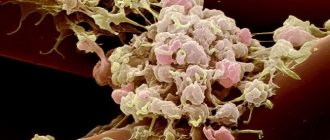Vaginal discharge is the result of the work of glands located in the vaginal mucosa. By the nature of the discharge, you can assess the condition of the female genital organs.
Normal vaginal discharge is not considered a disease, as it is necessary for the normal functioning of the reproductive system. In the vestibule of the vagina and near the cervix there are secretory glands that produce mucus necessary to moisturize the mucous membrane and form healthy microflora. Healthy discharge is formed in a small volume, it is transparent, odorless and not accompanied by pain or itching. When the type of discharge changes, this indicates the presence of a pathological process in the female genital organs.
What kind of discharge between menstruation is considered normal?
The content of the article
Female discharge normally consists of cervical mucus, dead mucosal cells, fluid (secret) secreted by the vaginal glands, and lactic acid. In the secretions of a healthy woman, lactic acid bacteria (Doderlein bacilli), a small amount of cocci and other microorganisms that do not cause harm are found. Normally, vaginal discharge is slightly acidic. This environment prevents pathogenic microbes from multiplying.
The main function of normal female secretions is to protect the uterus and vagina from infections and moisturize the inner surface of the organ. In a healthy girl, the first discharge begins shortly before the start of menstruation. The amount and characteristics of vaginal discharge are influenced by the hormonal background of the body, sexual activity, the stage of the menstrual cycle and the condition of the internal genital organs - the uterus, ovaries, appendages.
On the Internet, on forums, you can often find information that women should not have noticeable discharge between periods. Since they are released and absorbed in equal volume. In practice, this is certainly not the case - most healthy women notice discharge.
The importance of the secret and its composition
Many women try to get rid of any vaginal discharge, considering it unnatural and pathological. But cervical fluid or mucus plays an important role in the functioning of the reproductive system and maintaining women's health.
Normal vaginal secretion has the following composition:
- Cellular and fluid components. The uterine mucosa is constantly renewed, old cells die off, join the vaginal fluid and come out. Plasma and lymph transudate may be present.
- Cervical mucus. The cervix contains special glands that produce secretion, thereby protecting the reproductive system from penetration and further proliferation of pathogenic microorganisms.
- Bacteria and fungi of the vaginal flora. Sexual microflora contains not only beneficial lactobacilli, but also conditionally harmful microorganisms in small quantities. In a healthy girl, these pathogens die and come out along with vaginal secretions.
- Leukocytes. Based on their content, the presence of an inflammatory process can be diagnosed. The norm limit is 10 pcs. in the smear, but minor deviations are allowed.
Female secretions have many functions:
- self-cleaning of the vagina;
- maintaining healthy microflora;
- fight against harmful bacteria, rods, fungi;
- natural hydration during sexual intercourse;
- removal of dead cells;
- protection of the fetus during pregnancy.
The most important purpose of vaginal secretion remains the early warning of a woman about unfavorable processes in the reproductive system.
What does normal discharge look like in women?
The discharge of a healthy woman is similar to mucus without a strong odor and is not too abundant. They lubricate and cleanse the mucous membrane, protecting it from drying out and irritation.
Immediately after the end of menstruation, the discharge is scanty, then its quantity increases. Before ovulation (up to 12-16 days) they are transparent, watery, then they become more cloudy and viscous. The volume of discharge is individual for each woman. Discharge increases with stress, sexual arousal and pregnancy. Bakes up to 2 ml of leucorrhoea per day. An increase in the volume of secretions during ovulation means the egg is ready for fertilization. This occurs in the middle of the menstrual cycle and helps determine the maximum likelihood of conceiving a child.
In different situations, normal vaginal discharge from a woman can have different structure, consistency and color. Here's what they are like:
- Mucous discharge of a transparent color.
- Creamy discharge in small quantities (in the second half of the cycle, after the ovulation period).
- Copious, jelly-like discharge without color or odor (before the onset of menstruation).
- Whitish or yellow discharge with small clots (after sex without a condom).
- Copious white discharge (in the morning after unprotected sex).
- Bloody discharge (during menstruation).
- Dark spotting (while taking contraceptives.
- Liquid discharge of a light shade that does not cause discomfort (during pregnancy).
When sick, the composition and volume of secretions changes. Discharge in women becomes profuse, foul-smelling with a yellow, green and reddish tint. Leucorrhoea irritates the mucous membrane and skin of the perineum. If such symptoms appear, you should consult a doctor and get a smear for STDs and vaginal flora.
About consultation with a gynecologist / Consultation of a gynecologist
Our clinic employs gynecologists of the highest and first certification categories. All doctors have certificates confirming their qualifications, issued in St. Petersburg and Moscow. The cost of an initial appointment with a gynecologist is 1000 rubles, a consultation based on test results or ultrasound is 500 rubles. You can make an appointment with a gynecologist without an insurance policy, registration in St. Petersburg and Russian citizenship. We have gynecologists and ultrasound specialists who speak English.
Gynecologist appointment
You can apply to us without having an insurance policy, registration in St. Petersburg and Russian citizenship.
ATTENTION! IN THE CLINIC IS A DOCTOR SPEAKING IN ENGLISH LANGUAGE!
Factors affecting vaginal secretion
If we consider what a woman’s discharge should normally be, in terms of quantity, consistency, taste and smell, we need to pay attention to the vital processes of a particular woman.
Volume
So, during sexual intercourse, due to arousal, blood flow in the pelvis greatly increases, which causes more vaginal transudate to be released. This lubricant is necessary so that the walls of the vagina are not injured when the penis is inserted.
Mucus released during sex.
Abundant liquid lubrication can bother a woman immediately after intercourse. Such discharge often appears after unprotected sexual intercourse with a new sexual partner. In this case, the lubricant plays a protective role, trying to get rid of foreign microflora introduced by the penis. This phenomenon usually occurs no more than a few times and should not be accompanied by additional discomfort. After the vaginal microflora adapts to the microflora of a permanent partner, this phenomenon will no longer be a concern.
Taste
Bitter or sweet discharge in women is usually not a sign of pathology. The taste of vaginal secretions can naturally be affected by foods, drinks, or bad habits. The diet can change the level of acid-base balance, changing the taste sensation to more sour, sweet or bitter, within a few days. Taste characteristics may also change due to hormonal changes, emotional stress or medications.
Close attention should be paid if you or your sexual partner notice a taste of urine, fish or metal. This may indicate the development of harmful bacteria, pathologies of the urethra or uterus.
Aroma
To understand what the normal smell of discharge in women is, it is important to pay attention to the habits of a particular woman, hormonal balance, living conditions and psychological state. An ideally healthy girl has almost no odor or may be slightly sour.
For natural reasons, the aroma may change with changes in the acidity level of the vagina. Normally, it should be high, but during menstruation, after sex or when eating certain foods, an alkaline environment may temporarily begin to predominate, along with which the smell changes slightly. Another common problem is urine odor.
Typically, this phenomenon may mean that the urethra is located too close to the vagina. A more serious problem is when an unpleasant odor appears due to incontinence. The cause may be hidden in diseases of the bladder and requires its treatment.
Physiological discharge in women is not an anomaly and usually does not require special treatment. However, it is important to remember that many pathologies and inflammatory processes can be practically asymptomatic for a very long time. Therefore, even with minor changes in vaginal secretion, it is better to consult a doctor.
Pathological leucorrhoea and age
In childhood and adolescence, excessive leucorrhoea is caused by helminthic infestations, allergies, hormonal imbalances, and improper development of the genital organs. When antibiotics are taken irrationally, girls develop thrush. In 30% of cases, purulent discharge is caused by an infection that has entered the genital tract through the blood or lymph. In children, there are cases of household infection with STDs. In the childbearing age, among the causes of leucorrhoea, the leading causes are infections (60-70%) caused by cocci, protozoa and Candida fungi. It is not uncommon for tumors to cause light discharge, which women mistake for thrush or allergies. Discharge increases during pregnancy and after childbirth. This is a normal variant that does not require treatment. Abundant vaginal secretions during menopause and menopause are often caused by cancer or precancer. Therefore, if it occurs, you need to be examined by a gynecologist. At this age, leucorrhoea is often caused by prolapse (prolapse) of organs and atrophy of the mucous membrane.
White discharge
During puberty, vaginal discharge may be a consequence of inflammation of the intestines, bladder, uterus or ovaries. These episodes include pain associated with urination, intestinal colic, or pulling sensations in the lower abdomen and lumbar region. The temperature may rise, a blood test will show signs of inflammation (leukocytosis, increased ESR): then treatment for inflammation will be needed.
10-12 months before the onset of the first menstruation, the vaginal mucosa reacts to hormonal changes and liquid, transparent or white discharge is formed, the color of highly diluted milk, odorless or sour. No measures need to be taken if there are no complaints of burning or itching in the perineum, and the discharge does not take on a cheesy appearance.
After the onset of sexual activity, the consistency and composition of the discharge changes, the reason is the addition of the partner’s microflora, which is different in composition from the vaginal flora. It takes time to adapt, different in each case, and the situation will return to normal again. During the adaptation period, the volume of secretion increases, the discharge becomes more liquid, with a pale yellowish or whitish tint. A change in sexual partner is almost always associated with a change in the nature of vaginal discharge.
Taking contraceptives or breastfeeding reduces normal secretion: vaginal discharge is scanty and thick, white or yellowish in color.
Thrush (candidiasis) produces white, curd-like discharge, abundant, and sour in smell. Sometimes the discharge resembles yellowish curd lumps or white flakes. The disease is accompanied by itching and swelling of the genitals, irritation of the skin of the perineum. The development of candidiasis is a sign of decreased immunity.
curdled white coating in the vagina due to thrush
Thrush is often combined with STDs (genital herpes, ureaplasmosis, gonorrhea, trichomoniasis) and HIV infection, and manifests itself in metabolic diseases (diabetes mellitus) and tumors. Candidiasis definitely requires treatment.
Types of discharge with signs of pathology
The following types of discharge are distinguished:
- Vaginal
. Any healthy woman has them. If their number and volume increase, then the body probably has diseases associated with the genitourinary system, for example, colpitis. To accurately determine the cause, you need to submit a vaginal smear for examination. - Vestibular.
This discharge is most often white and is a symptom of inflammation of the external genitalia and glands. - Pipe
. This is the rarest group of discharges accompanying inflammation of the fallopian tubes. - Cervical
. As the name implies, they are formed due to erosion, polyps and other inflammatory processes in the cervix. - Uterine
. They are caused by fibroids, malignant tumors, and inflammation of the uterine mucosa.
Determining the source of the discharge is very important, and only a gynecologist can do this.
Prevention and recommendations
There are basic recommendations that it is advisable to follow for preventive purposes to maintain the health of the genital organs:
- the use of barrier methods of contraception when frequently changing sexual partners to prevent infection with sexually transmitted infections;
- observing the rules of intimate hygiene prevents the proliferation of microorganisms and allows you to notice pathological discharge in time;
- maintaining a healthy lifestyle to strengthen the immune system, protect against hypothermia and increase stress resistance;
- regular visits (every 6 months) to a gynecologist in order to be fully examined and treated in a timely manner;
- reasonable use of medications, especially antibiotics and hormonal agents. Only after consultation with a specialist should you begin treatment without prescribing medications yourself;
- giving up bad habits, which invariably affect the reproductive system, preserves the health and reproductive function of the female organs.
The secretion of mucus is a physiological process in the female body. Its consistency changes depending on the action of various factors. Most often this is a clear discharge without color or odor or extraneous symptoms. If additional changes occur in the discharge, you should seek help from specialists.
Photo: discharge in women - normal and pathological
discharge in women
discharge in women
purulent discharge
bloody, brown discharge
mucus discharge
curdled discharge
Age variants of the norm
Experts distinguish several types of physiological leucorrhoea, depending on age, intimate life and periodic hormonal surges. During the examination, the gynecologist must take into account all these factors.
Normally, girls do not have any discharge until they are 13-14 years old. The appearance of copious discharge with a putrid odor, with a whitish-gray or green color indicates the development of an inflammatory process in the organs of the reproductive system or in nearby structures (bladder, intestines).
6-12 months before the onset of menstruation, girls' hormonal levels change, which provokes the formation of discharge. Normally, they protect the genitals from pathogenic microorganisms and provide hydration to their walls. If the girl is completely healthy, the discharge will not be abundant, mucous, white or with a slight yellowish tint. Normal vaginal discharge is odorless and colorless, and certain clinical manifestations (burning, itching in the mucous membranes, redness of the skin, rash) should not bother you.
When a regular cycle is established, the nature of the leucorrhoea will change somewhat:
- From 1 to 12 days after menstruation, that is, during the first half of the cycle, the discharge is transparent, mucous, scanty, and has a liquid structure. The norm is whitish and yellowish odorless discharge.
- During the process of ovulation (usually 13-15 days after menstruation), the discharge is already thicker, more viscous, and acquires a light beige color, noticeable on underwear.
- From the 16th day until the beginning of the next menstruation, the volume of discharge decreases again. The consistency is slimy, jelly-like, and yellowish in color. The presence of spotting brown and then bloody discharge indicates the onset of menstruation.
In this case, the nature of the discharge changes under the influence of fluctuations in the level of sex hormones and is not a symptom of the presence of any pathology. While taking combined oral contraceptives, the amount of vaginal discharge can decrease significantly, mainly due to suppression of ovulation.
Table: types of discharge in women with genital diseases
| Types of discharge | Diseases |
| Vestibular (external) | Vulvitis, bartholinitis, allergies, precancerous conditions, malignant tumors |
| Vaginal | Colpitis, oncology, latex allergy, improper use of tampons |
| Cervical (cervical) | Cervicitis, cervical erosion, improper use of cervical caps, cancer |
| Uterine | Endometritis, endometriosis, uterine displacement, tumors, untimely removal of the IUD |
| Pipe | Inflammation of the appendages, ovarian cysts |
How to maintain proper hygiene
In order to prevent the development of many infections, it is important to follow the rules of personal hygiene. First of all, use properly selected hygiene products for washing with a minimum content of chemicals and a large percentage of plant extracts or lactic acid, which allow you to restore the natural microflora of the vagina. The water should not be hot or cold - it is optimal to set the room temperature.
Also during discharge, it is important to use hygienic, daily, moisture-absorbing pads, and also change them in a timely manner. Take your choice of linen seriously - it is advisable to choose exclusively natural fabric and exclude synthetics. They should be loose and not tight on the body, rubbing it. The sexual partner is permanent, and if sex is unprotected, it is advisable to use a condom. If sex was unprotected, it is important to get examined by a doctor, thereby excluding STD infection.
When should discharge be a concern? About this in the video:
Features of female discharge with dangerous signs
Discharge is distinguished by consistency, abundance and color. These signs make it possible to determine the presence of a certain gynecological disease in the body.
- Natural discharge between periods has the consistency of colorless, odorless mucus. If they become yellow, green or cheesy and are accompanied by purulent discharge, then this is an alarming signal indicating an infection.
- Discharge that is dark, pinkish or mixed with blood indicates a hormonal imbalance in the body or erosion of the cervix.
- Brown or pink spotting is considered the most dangerous to a woman’s life, especially if it appears during pregnancy. You should consult a doctor immediately, especially if the discharge is accompanied by the following symptoms: headache and abdominal pain, rapid heartbeat, weakness and low blood pressure, thready pulse, profuse sweating, pale skin.
Many diseases, incl. and STDs are asymptomatic. There are discharges, but they are not pathological and look normal. If the disease occurs in a latent form, it is almost impossible to diagnose it independently due to the absence of characteristic manifestations. Pathology can be detected during a routine examination. To do this, a woman must be examined by a gynecologist at least 2 times a year and take a smear, which will determine the presence of hidden diseases at the initial stage.
Popular questions
Hello!
I periodically have vaginal discharge, sometimes large lumps of white odorless, sometimes cheesy with some kind of sweetish smell, and sometimes a generally unpleasant fishy smell, always in different ways. There is no itching or burning, I don’t want to see a doctor yet, please tell me what can help in this situation? Hello! This is how bacterial vaginosis can manifest itself - a violation of the microflora in the genital tract. I recommend using Gynocomfort gel with tea tree oil, 1 dose once a day for 7 days. Contains herbal anti-inflammatory components, as well as local antiseptic bisabolol. This will normalize the microflora. Lactic acid will restore pH balance. If you do not track the effect, then be sure to contact your obstetrician-gynecologist for an examination aimed at finding out the cause of such complaints.
Hello. Constant white discharge. Either candidiasis or other microorganisms. There is no way to be cured. Doctors just prescribe medications and that's it. The partner is also treated. Could these be symptoms of a more serious illness?
Hello! When bacterial vaginosis recurs, it is important to exclude immunodeficiency conditions and diseases of the gastrointestinal tract. After the main course of anti-inflammatory therapy, it is imperative to carry out the stage of restoring the microflora in the genital tract and balancing the pH of the environment. For this purpose, the use of Ginocomfort gel with tea tree oil is suitable. The product is used in 1 dose for 10-14 days. It is also important to avoid microtrauma of the mucous membranes during contact. This is ensured by the use of lubricants. In the Ginocomfort line of products, it is possible to use a gel with mallow extract for this purpose.
Hello. Lately I've been having some discharge since my last session. What could it be? There is no smell, menstruation occurs monthly, but for the first time in days, pain appears in the pelvic area.
Hello! If unusual discharge from the genital tract appears, it is important to see an obstetrician-gynecologist as soon as possible and undergo an examination: a smear for flora, and, if necessary, examination for STIs, culture for nonspecific microflora. Atypical discharge may indicate the onset of an inflammatory process in the pelvic organs, which causes the appearance. While waiting for the result, you can use Gynocomfort gel with tea tree oil, which will have an anti-inflammatory effect and will not allow the infectious factor to spread.
I am 13 weeks pregnant and my discharge is smelly and brown in color.
Hello!
The appearance of discharge mixed with blood during pregnancy is an extremely dangerous situation, which may be a manifestation of the threat of miscarriage. Consult an obstetrician-gynecologist as soon as possible. For an accurate diagnosis, contact a specialist
Detailed signs of pathological discharge
Discharge in women is called pathological if it is a symptom of inflammation, tumors of the genital organs and STIs (sexually transmitted infections). In a healthy woman, discharge cannot cause burning, discomfort, itching, irritation or other unpleasant sensations. A microflora smear will show the number of leukocytes within normal limits, not increased.
Symptoms of pathological discharge requiring urgent diagnosis and treatment:
- Discharge that is brown, pink, or bloody any time outside of your period.
- The usual amount of menstrual blood changes: it becomes less, more. Menstruation passes with pain or disappears completely.
- Copious discharge of white, green, yellow, dark shades, uncharacteristic of the menstrual cycle.
- Discharge accompanied by itching, abdominal pain and an unpleasant odor.
If streaks of blood and clots appear in the vaginal discharge, and the leucorrhoea begins to look like meat slop, you need to urgently contact a gynecologist, take smears, blood and urine tests, and do an ultrasound. These are ominous symptoms indicating a high probability of cancer.
It is important to understand that the cause of discharge may not necessarily be a disease of the reproductive system. They can also be caused by other types of pathologies that have no connection with the genital organs. But in any case, the examination should begin with a gynecologist.
What diagnostics are needed for heavy discharge?
To find the cause of this phenomenon, standard studies of women are used:
- Flora smear, cytology, PCR;
- Colposcopy;
- Ultrasound of the uterus, tubes and ovaries;
- General tests;
- If necessary, consultation with a venereologist, urologist, endocrinologist.
Treatment will depend on the conclusion of a comprehensive diagnosis. These are antibiotics for infection, hormonal drugs for endocrine disruption, or surgery for polyps, endometriosis, and oncology. The threat of miscarriage in pregnant women is eliminated in a hospital setting.
Women should understand that by self-medicating or self-diagnosing, they worsen their condition. Symptoms disappear, and the disease progresses further. Only early detection can save the patient’s reproductive function and life. Even with the most modern equipment, there are doubts about the diagnosis, and what can we say about independently determining the disease.
Table: discharge in women indicating diseases
At the slightest suspicion of pathological discharge, you should immediately consult a gynecologist to determine its cause. By the appearance of the discharge, you can determine which gynecological disease it is a symptom of.
| Disease | Color, smell of discharge | Volume, consistency |
| Endometrial hyperplasia | Brown | Spotting |
| Endometritis | Dark | Thick, voluminous |
| Bend of the cervix | Bright red | Liquid with blood clots |
| Placental abruption | Bloody | Viscous, smearing |
| Purulent cervicitis | Greenish | Liquid with mucus |
| Chronic endometritis | Ichor | Liquid with an unpleasant odor |
| STI | Green | Liquid |
| Vaginal dysbiosis | Yellow or green | Thick |
| Candidiasis (thrush) | White, with the smell of sour milk | Curdled, volume depends on the severity of the disease |
| Adnexitis, vaginitis | Yellowish | Scarce |
| Inflammation of the ovaries | Green | Abundant |
| Cervical erosion | Bright red | Liquid |
| Inflammation of the uterus | Transparent | Thick |
| Microbial vaginosis | Cloudy-milky, with an unpleasant odor | Liquid, normal volume |
| Gonorrhea | Yellowish-green, with a putrid odor | Thick, scanty |
| Chlamydia | Transparent yellow, with a rotten smell | Abundant, liquid |
| Trichomoniasis | Yellowish-green, unpleasant odor | Abundant, foamy |
| Gardnerellosis | Transparent white or dirty gray, smell of stale fish | Liquid, abundant |
It should be remembered that blood after sexual intercourse in combination with abdominal pain is not normal and requires an immediate visit to the gynecologist. A visit to the doctor is also necessary a week after the abortion for an ultrasound scan, regardless of the presence of discharge.
CLICK TO MAKE AN APPOINTMENT, TEST OR ULTRASOUND
If you find an error, please select a piece of text and press Ctrl+Enter
When a doctor's help is needed
The appearance of unpleasant sensations in the groin area and smears with an unpleasant odor is a reason to immediately consult a gynecologist. If necessary, you should take an ultrasound, smear and blood, as well as other tests prescribed by your doctor.
Prevention
It is easier to prevent a disease than to undergo therapy. So, in order to reduce the likelihood of pathologies of the reproductive system, you need to get rid of bad habits, reduce the consumption of harmful foods, giving preference to proper nutrition.
You should avoid exhaustion of the body, excessive physical exertion, and do not take medications, including antibiotics and OK, without medical supervision. You should not have sex without a condom unless you are sure that your partner does not have sexually transmitted diseases. It is important to maintain hygiene and avoid hypothermia.










